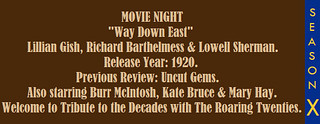
Review #1331: Coquette.
Cast:
Mary Pickford (Norma Besant), Johnny Mack Brown (Michael Jeffery), Matt Moore (Stanley Wentworth), John St. Polis (Dr. John Besant), William Janney (Jimmy Besant), Henry Kolker (Jasper Carter), George Irving (Robert Wentworth), and Louise Beavers (Julia) Directed by Sam Taylor (#667 - The Freshman, #727 - For Heaven's Sake, #758 - Safety Last!, #864 - Hot Water, #903 - Dr. Jack, #918 - Why Worry?, and #938 - Girl Shy)
Review:
"I am no longer in pictures for money. I am in them because I love them. I am not in vain. I do not care about giving a smashing personal performance. My one ambition is to create fine entertainment."
Mary Pickford was a star in a time of transition for Hollywood in 1929. Born in Toronto, Canada in 1892, she had grown up with the theatre from a young age, with her mother having taken the suggestion of one of her boarders, a theatrical stage manager to give her two daughters small roles in a production. Years of touring with her family in the theatre were soon changed in 1909 after encountering D. W. Griffith (of the Biograph Company at the time) for a screen test, which led to her being hired to appear (both in bit parts and lead roles) in the company's films; despite not being credited, she received notices from audiences. She left for Adolph Zukor’s Famous Players studio in 1912 and found continued success with films such as Tess of the Storm Country (1914) and The Poor Little Rich Girl (1917). Pickford was also an innovator when it came to studios, as she was one of the co-founders of United Artists in 1919 alongside Griffith, Charlie Chaplin and Douglas Fairbanks, which was formed on the premise of giving creative control to the actors and directors. The burgeoning of the sound era did not deter Pickford from acting. Although she had famously said that adding sound to film would be "like putting lip rouge on the Venus de Milo", Pickford was nervous but ready to debut her voice onto film (she had not appeared in a film since My Best Girl in 1927). When she heard her voice for the first time for a test, she remarked that she sounded like a pipsqueak (ironic for someone who had played numerous child characters since a teenager). She soon did voice training to try and get herself ready to play this southern role with equipment that would try to stick out from the stagey static sound films that encompassed the early sound films.
The film was adapted to the screen by John Grey, Allen McNeil, and director Taylor from the play of the same name by George Abbott and Ann Preston Bridgers, which had featured Helen Hayes in the main role. The play was about a flirty young woman who has to decide what to do after her father kills the man she loves. The manner of who commits suicide is actually the choice of the main character (who was pregnant), as opposed to the film, where it is the father who does so in the midst of his court trial, where his daughter struggles to try and save her father from a death sentence. As for the film itself, it is one that seems more appropriate to give slack for rather than one to give much credit for. It is a middling affair, helmed by a fairly confident Pickford and not much else. It is a fairly clunky affair, filled with plenty of stagy staleness begging to be drawn out more through a 76 minute time that somehow seems ten minutes too long. One would wish more from Pickford, only to realize that she is the key in keeping it from collapsing into being forgettable all together. She seems bright and vivid in a way that the rest of actors are left to act around her with a bit too much camp to go around. There would be plenty of stories to tell about flirtatious or quirky Southern folk to come, some classics and some not: this is one that twists in the wind of the latter category.
Pickford (a founding member of the Academy of Motion Picture Arts and Sciences) lobbied with a publicity campaign when it came time to awards season (whereas other nominees didn't even know they were nominated), the first of its kind that seems routine nowadays (with this case being inviting the judges for tea at her estate Pickfair). In any case, Pickford won for Best Actress at the 2nd annual ceremony. She would appear in four more films in the next four years before retiring from acting (although she would keep producing before selling her UA stocks in the 1950s). While the film may not hold itself too well after nine decades, it has not stopped Pickford from enduring as one of film's first and brightest stars, where the term of "America's Sweetheart" just seemed fairly appropriate for her.
Overall, I give it 6 out of 10 stars.
Next Time: As you could tell, Tribute to the Decades decided to go all out and actually try to cover each year for the 1920s. As such, it will continue for the 1930s.


 Review #1330: The Broadway Melody.
Review #1330: The Broadway Melody. Review #1329: Pandora's Box.
Review #1329: Pandora's Box.


 Review #1325: Underworld.
Review #1325: Underworld.


 Review #1321: The Sea Hawk (1924).
Review #1321: The Sea Hawk (1924).



 Review #1316: Uncut Gems.
Review #1316: Uncut Gems.